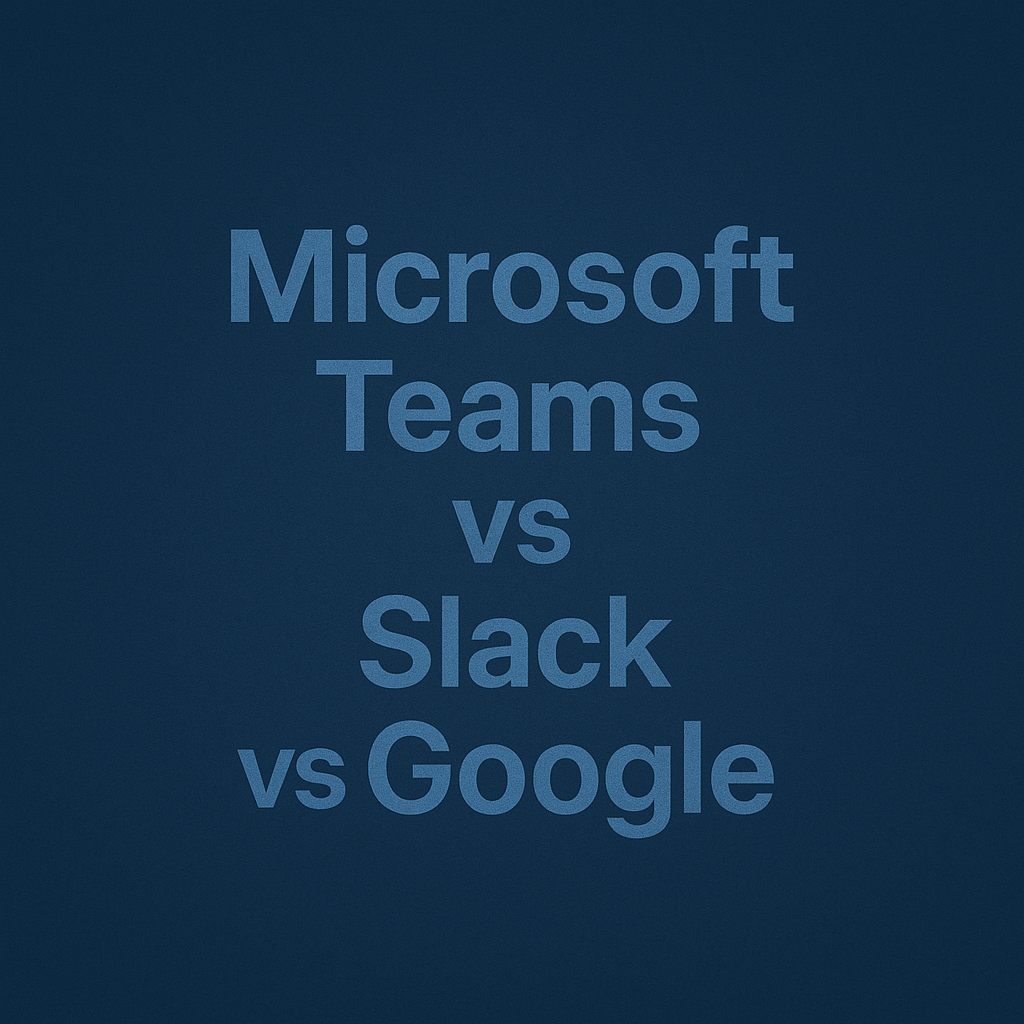If you are looking for the best communication or collaboration tool or platform for your business or organization, then you are on the right page. In this guide, you willl understand everything about Microsoft Teams vs Slack vs Google Chat so you can make the right investment.
With remote and hybrid work becoming the norm, selecting the right communication tool can significantly impact productivity, workflow efficiency, and team morale.
This comparison dives deep into user experience, integrations, pricing, security, AI tools, and real-world performance among other insights.
Contents
- 1. User Experience (UX) & Interface
- 2. Integration and Ecosystem Compatibility
- 3. Video Conferencing & Real-Time Collaboration
- 4. Security, Compliance, and Admin Controls
- 5. Pricing and Plans (May Change with Time)
- 6. AI Features and Workflow Automation
- 7. Which Tool Is Best for Your Use Case?
- Final Recommendations
- Final Thoughts
1. User Experience (UX) & Interface
Slack
- Intuitive and fast user interface.
- Real-time notifications, custom emojis, and a familiar layout.
- Ideal for teams that value a polished and responsive experience.
Microsoft Teams
- Rich in features, but can feel bloated or overwhelming for new users.
- Nested tabs, chat threads, and deep Microsoft 365 integration.
- Better suited for enterprise users comfortable with Microsoft tools.
Google Chat
- Minimalist interface consistent with other Google products.
- Easy navigation, but lacks the polish and responsiveness of Slack.
Verdict: Slack leads in UI simplicity and responsiveness. Google Chat is clean but basic. Teams has a steeper learning curve but is powerful for Microsoft-centric teams.
2. Integration and Ecosystem Compatibility
Slack
- 2,600+ integrations including Zoom, Trello, GitHub, Google Drive, etc.
- Highly customizable workflows and bots.
Microsoft Teams
- Deep native integration with Office apps like Word, Excel, OneNote, and SharePoint.
- Powerful for document collaboration and file management.
Google Chat
- Seamlessly works with Gmail, Google Calendar, Drive, and Meet.
- Limited third-party integrations compared to Slack.
Verdict: Slack is the most flexible across ecosystems. Teams and Chat shine within their native platforms.
3. Video Conferencing & Real-Time Collaboration
Slack
- Huddles and Clips for quick audio/video communication.
- Limited for large or formal meetings.
Microsoft Teams
- Advanced video conferencing: breakout rooms, live captions, meeting transcripts.
- Ideal for enterprise and hybrid meeting environments.
Google Chat (via Google Meet)
- Simple video conferencing with screen sharing, noise cancellation.
- Lacks advanced meeting controls.
Verdict: Teams dominates in video collaboration. Slack is adequate for small teams. Google Chat + Meet is basic but usable.
4. Security, Compliance, and Admin Controls
Slack
- SOC 2, ISO/IEC certifications, SSO, and enterprise-grade security.
- Occasional service outages have been reported.
Microsoft Teams
- Industry-leading compliance: HIPAA, GDPR, SOC, FedRAMP.
- Tightly integrated with Microsoft Defender and Azure Active Directory.
Google Chat
- Encrypted in-transit and at-rest, Google Workspace security backbone.
- Suitable for HIPAA-compliant use.
Verdict: Microsoft Teams is best for regulated industries. Google Chat is reliable for general security. Slack is secure but with less enterprise-level control.
5. Pricing and Plans (May Change with Time)
Slack
- Free: 90-day message history, 10 integrations.
- Pro: about $8.75/user/month.
- Business+: about $15/user/month.
Microsoft Teams
- Free version available.
- Essentials: about $4/user/month.
- Included in Microsoft 365 Business plans (about $6 to $22/user/month).
Google Chat
- Free for Google account holders.
- Included in Google Workspace: about $6 to $18/user/month.
Verdict: As we speak, Google Chat and Microsoft Teams offer the most value within their suites. Slack can get expensive for larger teams needing full access and AI features.
6. AI Features and Workflow Automation
Slack
- Slack AI (meeting recaps, smart searches).
- Workflow Builder for custom automation.
Microsoft Teams
- Microsoft Copilot integration for live transcription, smart meeting recaps, task suggestions.
Google Chat
- Basic AI features: summaries and translation.
- Lacks robust automation tools.
Verdict: Microsoft Teams and Slack are leading the AI innovation. Google Chat is catching up but still limited.
7. Which Tool Is Best for Your Use Case?
| Use Case | Best Option | Why |
|---|---|---|
| Fast chat + integrations | Slack | Superior UI, extensive third-party apps |
| Enterprise collaboration | Teams | Full-featured meetings, security, admin tools |
| Google Workspace teams | Google Chat | Seamless Gmail/Drive/Meet integration |
Final Recommendations
Choose Slack if:
- You need a highly customizable, user-friendly chat tool.
- You use a mix of third-party tools (Trello, Zoom, Google Drive, etc).
Choose Microsoft Teams if:
- Your team uses Microsoft 365 tools daily.
- You need powerful video conferencing and strict compliance.
Choose Google Chat if:
- You’re already using Google Workspace.
- You want a no-frills, secure, cost-effective communication tool.
Final Thoughts
No single tool is perfect for everyone. Instead of asking “Which is better?”, ask “Which is better for us?”
Use this guide to match your team’s size, tech stack, budget, and communication habits to the right tool. Whether you prioritize simplicity, scalability, or security, there’s a platform that fits perfectly.

